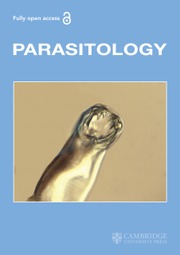Crossref Citations
This article has been cited by the following publications. This list is generated based on data provided by
Crossref.
Szuba, Andrzej
2005.
Literature Watch.
Lymphatic Research and Biology,
Vol. 3,
Issue. 1,
p.
36.
Anthony, Robert M.
Rutitzky, Laura I.
Urban, Joseph F.
Stadecker, Miguel J.
and
Gause, William C.
2007.
Protective immune mechanisms in helminth infection.
Nature Reviews Immunology,
Vol. 7,
Issue. 12,
p.
975.
Vedi, Satish
Dangi, Anil
Hajela, Krishnan
and
Misra-Bhattacharya, Shailja
2008.
Vaccination with 73kDa recombinant heavy chain myosin generates high level of protection against Brugia malayi challenge in jird and mastomys models.
Vaccine,
Vol. 26,
Issue. 47,
p.
5997.
Shakya, Shilpy
Kumar Singh, Prashant
Kushwaha, Susheela
and
Misra-Bhattacharya, Shailja
2009.
Adult Brugia malayi ∼34 kDa (BMT-5) antigen offers Th1 mediated significant protection against infective larval challenge in Mastomys coucha.
Parasitology International,
Vol. 58,
Issue. 4,
p.
346.
Shakya, S.
Srivastava, A.K.
and
Misra-Bhattacharya, S.
2009.
AdultBrugia malayimitochondrial and nuclear fractions impart Th1-associated sizeable protection against infective larval challenges inMastomys coucha.
Journal of Helminthology,
Vol. 83,
Issue. 1,
p.
83.
Singh, Meghna
Shakya, Shilpy
Soni, Vishal Kumar
Dangi, Anil
Kumar, Nikhil
and
Bhattacharya, Shailja-Misra
2009.
The n-hexane and chloroform fractions of Piper betle L. trigger different arms of immune responses in BALB/c mice and exhibit antifilarial activity against human lymphatic filarid Brugia malayi.
International Immunopharmacology,
Vol. 9,
Issue. 6,
p.
716.
Carsillo, Mary
Kutala, Vijay Kumar
Puschel, Karen
Blanco, Jorge
Kuppusamy, Periannan
and
Niewiesk, Stefan
2009.
Nitric oxide production and nitric oxide synthase type 2 expression by cotton rat (Sigmodon hispidus) macrophages reflect the same pattern as human macrophages.
Developmental & Comparative Immunology,
Vol. 33,
Issue. 5,
p.
718.
Joseph, S.K.
Verma, S.K.
Sahoo, M.K.
Dixit, S.
Verma, A.K.
Kushwaha, V.
Saxena, K.
Sharma, A.
Saxena, J.K.
and
Murthy, P.K.
2011.
Sensitization with anti-inflammatory BmAFI of Brugia malayi allows L3 development in the hostile peritoneal cavity of Mastomys coucha.
Acta Tropica,
Vol. 120,
Issue. 3,
p.
191.
Luo, HongLin
Huang, Weiyi
Wang, Dongying
Wang, Haoju
and
Nie, Kui
2011.
The absence of MyD88 has no effect on the induction of alternatively activated macrophage during Fasciola hepatica infection.
BMC Immunology,
Vol. 12,
Issue. 1,
Luo, H.L.
Wang, D.Y.
Wang, H.J.
Nie, K.
and
Huang, W.Y.
2011.
WITHDRAWN: MyD88 is required for the recruitment of eosinophils and neutrophils but dispensable for host protective immune responses during Fasciola hepatica infection.
Immunobiology,
Shrivastava, Nidhi
Singh, Prashant Kumar
Nag, Jeetendra Kumar
Kushwaha, Susheela
and
Misra-Bhattacharya, Shailja
2013.
Immunization with a multisubunit vaccine considerably reduces establishment of infective larvae in a rodent model of Brugia malayi.
Comparative Immunology, Microbiology and Infectious Diseases,
Vol. 36,
Issue. 5,
p.
507.
Prolo, Carolina
Álvarez, María Noel
and
Radi, Rafael
2014.
Peroxynitrite, a potent macrophage‐derived oxidizing cytotoxin to combat invading pathogens.
BioFactors,
Vol. 40,
Issue. 2,
p.
215.
Ruano, Ana Lucía
López-Abán, Julio
Fernández-Soto, Pedro
de Melo, Alan Lane
and
Muro, Antonio
2015.
Treatment with nitric oxide donors diminishes hyperinfection by Strongyloides venezuelensis in mice treated with dexamethasone.
Acta Tropica,
Vol. 152,
Issue. ,
p.
90.
Soeiro-Pereira, Paulo Vítor
Falcai, Angela
Kubo, Christina Arslanian
Antunes, Edson
and
Condino-Neto, Antonio
2015.
BAY 41-2272 activates host defence against local and disseminated Candida albicans infections.
Memórias do Instituto Oswaldo Cruz,
Vol. 110,
Issue. 1,
p.
75.
Verma, Shiv K.
Joseph, Sujith K.
Verma, Richa
Kushwaha, Vikas
Parmar, Naveen
Yadav, Pawan K.
Thota, Jagadeshwar Reddy
Kar, Susanta
and
Murthy, P. Kalpana
2015.
Protection against filarial infection by 45–49kDa molecules of Brugia malayi via IFN-γ-mediated iNOS induction.
Vaccine,
Vol. 33,
Issue. 4,
p.
527.
Macháček, Tomáš
Šmídová, Barbora
Pankrác, Jan
Majer, Martin
Bulantová, Jana
and
Horák, Petr
2020.
Nitric oxide debilitates the neuropathogenic schistosome Trichobilharzia regenti in mice, partly by inhibiting its vital peptidases.
Parasites & Vectors,
Vol. 13,
Issue. 1,
Oliveira, Fabrício Marcus Silva
Kraemer, Lucas
Cavalcanti da Silva, Caroline
Nogueira, Denise Silva
Gazzinelli-Guimarães, Ana Clara
Gazzinelli-Guimarães, Pedro Henrique
Barbosa, Fernando Sérgio
Resende, Nathalia Maria
Caliari, Marcelo Vidigal
Gaze, Soraya Torres
Bartholomeu, Daniella Castanheira
Fujiwara, Ricardo Toshio
and
Bueno, Lilian Lacerda
2022.
Nitric oxide contributes to liver inflammation and parasitic burden control in Ascaris suum infection.
Experimental Parasitology,
Vol. 238,
Issue. ,
p.
108267.


